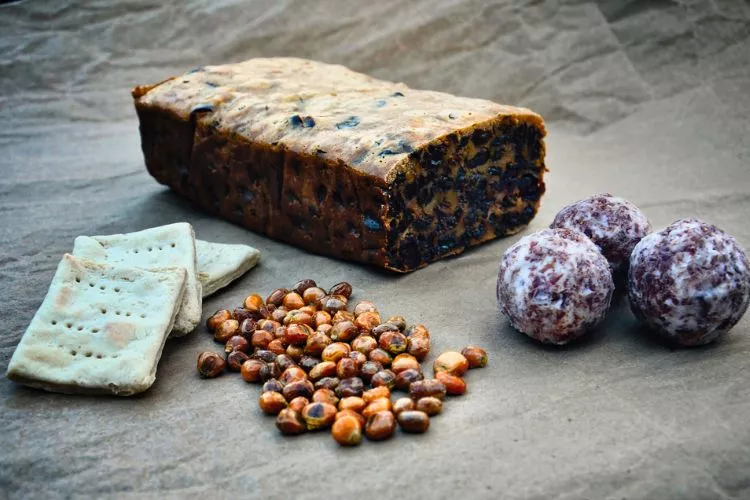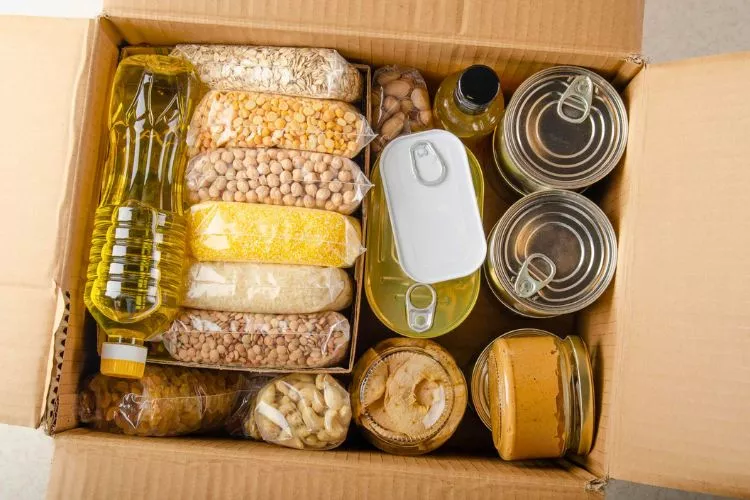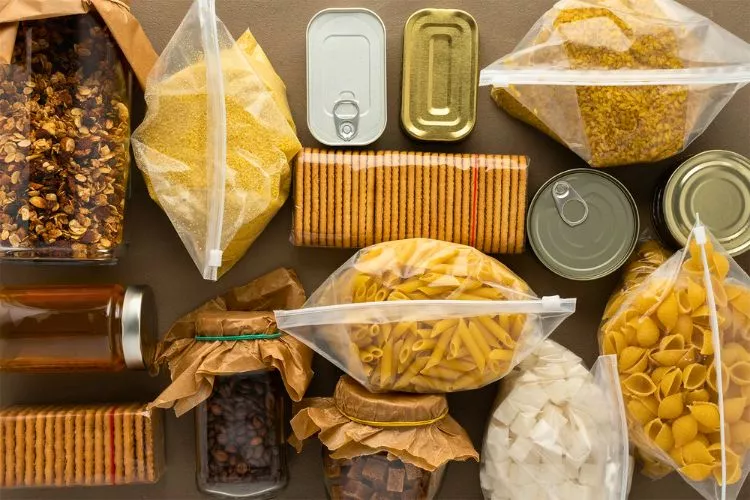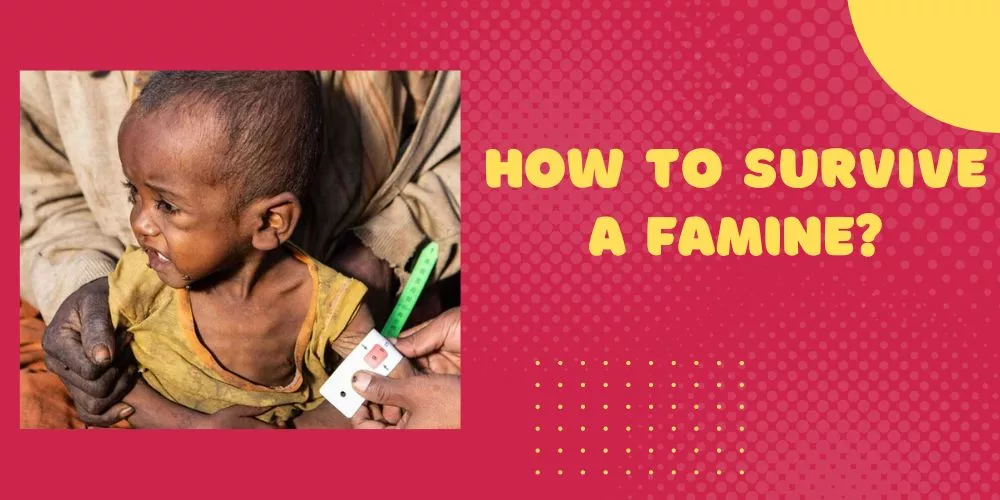Prepping for the uncertain future? Be it an apocalypse, natural disasters, or any emergency scenario – long-lasting doomsday rations are crucial to your survival.
That’s why I am writing this guide on how to make doomsday rations in an easy to understand manner.
In fact in this article, I will explore the essentials of creating nutritious, shelf-stable meals, ensuring you and your loved ones can thrive in any dire situation.

Get ready to stockpile your pantry like a pro!
How To Make Doomsday Rations? (A Step By Step Guide)
In the face of calamities or emergencies, having a stockpile of nutritious, long-lasting doomsday rations is indispensable.
This guide will give an extensive look into maximizing your survival prospects with canny meal planning, preserving techniques, and maintaining balanced nutrition.

Developing Your Stockpile Plan
The first step in your emergency preparedness plan is deciding what and how much to store. Consider each family member’s dietary needs and preferences, as well as any potential dietary restrictions.
- Estimate the Quantity: The most common advice is to store rations for 72 hours (three days), but it is advisable for preppers to prepare for a longer timeline, such as a month or even a year.
- Nutritional Value: Your rations should cover the five major food groups, providing a balanced diet rich in protein, carbohydrate, healthy fats, vitamins, and minerals.
- Special Dietary Needs: Considering canning or dehydrating foods that meet the specific needs of individuals such as infants, the elderly, or those with dietary restrictions.
Deciding What To Store
- Dry Foods: Essentials include grains like rice, barley, or oats, pasta, lentils, and beans.
- Canned Foods: Long-lasting, canned foods such as fruits, vegetables, meats, poultry, and fish are good.
- Preserved Foods: Consider preserved foods such as pickled fruits and vegetables, dried meats, or fruit leathers.
- Freeze-Dried Foods: These have a long shelf life and are lightweight so that they can be transported easily in case of an evacuation.
- Comfort Foods: Items like chocolate, coffee, or sweets, which can enhance morale during stressful times.
Preserving and Packing Foods
There are several methods for preserving your foods and making them last, such as canning, dehydrating, or freeze-drying.
- Canning: This method is excellent for preserving fresh vegetables, fruits, and meats. Ensure to use proper home canning methods for the safety of your canned food.
- Dehydrating: Nuts, fruit, vegetables, and even meat can be dried. Dehydrated food is light, takes up little space, and can last for years if properly sealed.
- Freeze-drying: Although more complex and costly, this method keeps food almost at its prime quality for longer periods.
Proper Storage
Ensure a cool, dry, dark storage space, preferably between 50-70°F (10-21°C), to maximize the shelf-life of your rations. Furthermore, pack your food in sturdy containers – airtight plastic or mylar bags are best for keeping out light, oxygen, insects, and rodents.
Continuous Monitoring
Never forget to regularly check your stockpile for expired items and replace them. Familiarize yourself with signs of spoilage and have a rotation plan to keep your stock fresh.
Keeping Water
In addition to food, having a proper water supply plan is crucial – humans can survive longer without food than water. Aim to store at least one gallon per person per day, considering consumption and hygiene needs.
Indeed, in addition to the basic steps provided, some additional considerations can further enhance your preparedness.
Secure Cooking Methods
Having a practical way to cook your meals is essential. Here are a few options you might consider:
- Portable Stoves: These can be a handy tool when you’re out of power, but always remember to use them in a well-ventilated area to avoid carbon monoxide buildup.
- Solar Ovens: These completely rely on sunlight, making them an energy-friendly option for outdoor cooking. They can bake, boil, and steam foods.
- Fuel Sources: Stockpile a supply of propane, wood, charcoal, or other sustainable fuel sources.
Develop Survival Skills
Skills such as hunting, fishing, foraging, and farming can be beneficial in scenarios where your food stockpile might not suffice.
- Hunting and Fishing: Develop skills that can help you procure protein sources in survival scenarios.
- Foraging: Local plant and wildlife knowledge can prove helpful to supplement your diet and avoid toxic species.
- Farming: A sustainable and self-sufficient way to secure food in the long run.
Educate Your Family
It’s essential to ensure that each family member understands the rationing plan. Teach them about serving sizes, how to prepare meals, how to monitor ration supplies, and when to consume preserved foods.
Develop a Communication and Emergency Response Plan
In addition to securing food and water, it’s important to have a robust family communication and emergency response plan.
This includes identifying safe places to shelter in your home, evacuation routes from your home and community, emergency contact numbers, and methods to communicate if traditional lines are down.
This plan naturally complements your rationing strategy, maximizing your well-being and survival in any given situation. It’s always better to be prepared for anything, and these additional steps go a long way in building a comprehensive emergency readiness plan.
Remember: Learning to make doomsday rations will take time and effort, but when done correctly, they can save lives during an emergency.
This guide gives a comprehensive outline to support your survival plan, ensuring you’re ready no matter what the future holds.
How do you make long lasting survival food?
Creating long-lasting survival food involves selecting the right ingredients, preparing them well, and properly storing them to maximize shelf life.
This in-depth guide covers all of these points and more to help you prepare for any emergency.

Choose Your Ingredients
Long-lasting survival foods typically share specific characteristics: they are nutrient-dense, non-perishable, and require little or no cooking. Initial ingredients selection is crucial to ensure maximum nutrition and shelf life.
- Protein: Choose beans, lentils, canned meats (chicken, tuna, turkey, salmon), and jerky.
- Carbohydrates: Consider rice, couscous, oats, pasta, wheat berries, and dried potato flakes.
- Fruits and Vegetables: Opt for canned fruits and vegetables (with low or no sodium options), dehydrated or freeze-dried options.
- Dairy: Store powdered milk or dried cheeses.
- Fats: Choose nuts, seeds, and nut butters, as well as olive or coconut oil (with a high smoke point).
Choose Your Preservation Techniques
Proper preservation techniques help create long-lasting survival food by reducing moisture, preventing spoilage, and ensuring optimal storage conditions. Consider the following methods:
- Canning: An excellent long-term preservation method for meats, vegetables, and fruits with a shelf life of up to 5 years, if properly sealed and stored.
- Dehydrating: Removing moisture using a dehydrator or oven to create foods such as jerky, fruit leather, and vegetable chips.
- Freeze-drying: Advanced technology removes moisture while retaining nutritional value, color, and taste, suitable for fruits, vegetables, and prepared meals.
- Dry Storage: Simple method for grains, beans, and pasta by keeping them in airtight, dry conditions.
Prepare Your Meals
Combine ingredients into balanced, nutrient-rich meal options. Ensure a variety of options to maintain interest and prevent meal fatigue. Example meals include:
- Chili or Stew: Combine canned or dehydrated vegetables, canned or dried beans, canned meats, and seasonings.
- Soup: Combine various canned or freeze-dried vegetables, meats, and starchy ingredients such as rice or pasta in a broth.
- Breakfast: Mix oats, dehydrated or freeze-dried fruits, and powdered milk for a nourishing porridge.
- Trail Mix: Create a blend of nuts, seeds, dried fruits, and chocolate for an energy-dense snack.
Package for Longevity
Proper packaging methods protect the integrity of your meals, ensuring long shelf life and preventing spoilage from oxygen, humidity, and pests.
- Vacuum Sealing: A vacuum sealer removes air from the food and seals it in an airtight package. This method is ideal for dried goods, jerky, and dehydrated fruits and vegetables.
- Mylar Bags: These metallic bags provide an oxygen and light barrier, often used as an inner lining for food storage buckets.
- Food-Grade Storage Buckets: These sturdy containers prevent rodents or other pests from damaging your supplies.
Store Properly
Choose a cool, dry, and dark location for storage, maintaining a temperature between 50-70°F (10-21°C). Consistent, cooler temperatures prolong food shelf life.
Rotate and Update
Mark all packages with the packing date and rotate your long-lasting survival food stock regularly to keep the food fresh. This can prevent spoilage and waste while ensuring you always have access to a supply of viable emergency rations.
By following this comprehensive guide, you will be well-equipped to create a stockpile of long-lasting survival food, providing essential sustenance for you and your loved ones during emergencies or disasters.
What is the longest lasting survival food?
some of the longest-lasting foods for survival include:

- Honey: Known for its near-infinite shelf life, honey is an excellent survival food that provides both sweetness and important nutrients.
- Salt: A critical element for food preservation and an essential dietary mineral, salt can last indefinitely.
- White Rice: Regular rice can last up to five years, while white rice stored in an oxygen-free container can last between 25 and 30 years.
- Apple Cider Vinegar: Known for its diverse utility in cleaning, food preservation, and health benefits, it can last almost indefinitely.
- Alcohol: Certain types of alcohol, like vodka or spirits, can last indefinitely and can be used for both consumption and disinfection.
- Bouillon Cubes: These are compact, flavor-packed cubes that are easy to store and can last several years.
- Instant Coffee: Though it may not be as tasty as freshly brewed coffee, instant coffee can last indefinitely and provide a much-needed morale boost in survival situations.
- Peanut Butter: It’s a good source of protein and doesn’t require refrigeration.
- Freeze-dried foods: These have been specifically designed to last up to 30 years when stored properly, making them an invaluable resource for long-term survival.
Just remember that the preservation depends on how these foods are packaged and the conditions in which they are stored.
What Are the Ingredients In the Doomsday Ration?
A well-planned doomsday ration comprises a variety of nutrient-rich, non-perishable ingredients that are easy to prepare and have a long shelf life. The ingredients usually fall into five main categories:
- Proteins: This can include canned or dried meats, such as chicken, tuna, or beef, legumes like dried lentils, chickpeas, or beans, and nuts and seeds like almonds or chia seeds for a plant-based protein source.
- Carbohydrates: As a crucial source of energy, carbs can include whole grains like brown rice or cracked wheat, dried pasta, and dried potato flakes. Carbohydrates can also include multigrain cereals and rolled oats.
- Fruits & Vegetables: Specific fruits and vegetables hold up well in canned or dehydrated forms, such as green beans, carrots, peaches, or apples. Freeze-dried fruits and vegetables are also a popular choice due to their reduced weight and space requirement.
- Fats: Healthy fats are important for brain function and cell growth. Options include canned or vacuum-sealed packages of nuts, seeds, oils (like olive oil or coconut oil), and nut butters.
- Dairy: Powdered milk and freeze-dried cheese are the best long-term storage options for dairy, as they provide the necessary calcium and vitamins without the need for refrigeration.
In addition to these, you may want to consider adding basic cooking and baking supplies like sugar, salt, baking soda, vinegar, and a selection of spices to your doomsday rations.
What Food Did They Eat In The Doomsday Ration?
In a typical doomsday ration, there exists a variety of food options that provide necessary nutrients for survival:

- Breakfast: Foods that provide quick energy, such as homemade granola bars, instant oatmeal, and powdered eggs, are typical.
- Lunch and Dinner: Meals often consist of pre-packaged dehydrated meals that only need water to prepare, such as rice and beans, freeze-dried chili, pasta dishes, or freeze-dried chicken and vegetables.
- Snacks: These can range from sealed packages of nuts and seeds to dried fruit, dehydrated berries, beef jerky, and powdered protein shakes.
- Desserts: Yes, even in a crisis, a sweet treat can do wonders for morale. Foods like powdered pudding mixes, canned fruit, and dehydrated ice cream are found in some doomsday rations.
The key here is diversity and balance. A quality doomsday ration should offer a satisfying variety of flavors and textures while also ensuring that each meal provides the essential nutrients needed for survival.
What Is the Most Powerful Survival Food You Can Make at Home?
One of the most powerful survival foods you can make at home is Pemmican. Originally prepared by Native Americans, it’s been a standard survival ration for explorers and soldiers throughout history. Here’s a simple recipe:
Ingredients:
- 2 cups Lean meat (deer, beef, bison, elk, etc.)
- 2 cups Dried fruit (cranberries, apricots, etc.)
- 1 cup Rendered fat (tallow or lard)
- 1/2 cup Honey (optional)

Preparation Method:
- Start by drying the meat in a dehydrator or oven until it’s brittle and crumbles easily. This will preserve the meat and extend its shelf life.
- Grind the dried meat into a fine powder using a food processor, blender, or by hand using a mortar and pestle.
- Following the same process, grind your choice of dried fruit into a fine powder.
- Mix the meat and fruit powders together in a large bowl. If you want to add sweetness, mix in the honey at this point.
- Melt the rendered fat on the stove until it becomes liquid.
- Slowly add the melted fat to your meat and fruit mixture, stirring until the mix becomes a thick paste.
- Press the mixture into a shallow pan and allow it to cool. Once cooled, it can be cut into bars.
- Store the pemmican bars in airtight containers. They can last years if kept in a cool, dark, and dry place.
Pemmican is a simple recipe packed with vital protein and calories that can be easily stored. It provides sustained energy and is perfect for survival situations.
Frequently Asked Questions (FAQs)
What’s Safe to Eat After Nuclear Fallout?
In the unfortunate event of nuclear fallout, non-perishable, pre-packaged, or sealed food and bottled drinks are safest to consume, as they’re less likely to be contaminated. Canned foods, vacuum-sealed pouches, and foods in jars provide a measure of protection. It’s advisable to wipe packaging before opening to remove any potential radioactive particles.
What Foods Have Indefinite Shelf Life?
Foods with an indefinite shelf life include honey, salt, sugar, white rice, dried beans, and certain hard liquors. Additionally, foods that are freeze-dried, dehydrated, or packed in cans can last for an extended period, typically between 2-25 years depending upon the specific food.
What Food Should You Stockpile for a Nuclear War?
For a nuclear war scenario, it’s best to stockpile high-nutrition, non-perishable foods. Stock foods high in protein like powdered milk, canned fish/meat, dried beans or lentils, and food items like peanut butter. Also consider carbohydrates like white rice and rolled oats. Canned fruits and vegetables can offer necessary fibers and nutrients. Don’t forget essentials like honey, salt, and cooking oil.
How Much Food Do You Need to Survive a Nuclear War?
The recommended amount of food to survive a nuclear war is about two weeks’ worth of supplies for everyone in your household, as per FEMA. Ideally, prepare to stock 1 gallon of water per person per day and around 2,000 calories of food. However, it’s advisable to plan for long-term scenarios, increasing your stockpile to last several months or even up to a year.
Conclusion:
Understanding how to make doomsday rations is vital for disaster preparedness. It involves stockpiling a variety of nutrient-dense, non-perishable foods that can sustain you and your loved ones in an emergency scenario.
Remember, a good doomsday ration should incorporate proteins, carbohydrates, fruits & vegetables, fats, and dairy products. Consider diversifying with meals like pemmican and prioritizing an adequate water supply.
By preparing these rations and ensuring a balanced diet, you ensure your readiness for any situation, from nuclear war to natural disaster.
After all, being prepared can make a potential doomsday scenario a little less daunting.


